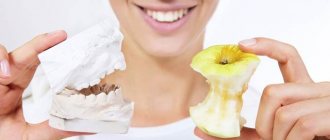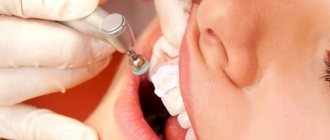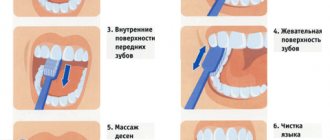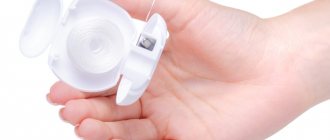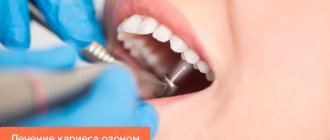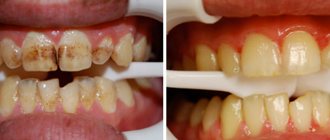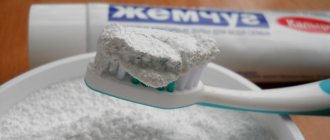Proper and daily oral care prevents the formation and accumulation of bacterial plaque, which is one of the main causes of caries and gum inflammation.
The main role in maintaining oral health is played by the correct use of high-quality oral hygiene products. It is important not only to select them with the help of a dentist, but also to strictly adhere to the regimen and technique of their use.
For daily brushing of teeth, in addition to a toothbrush and toothpaste, you need a small set of products:
- tongue cleaning brush;
— floss (interdental floss) for cleaning the side surfaces;
— superfloss (thread) for cleaning braces, bridges and wide spaces between teeth;
— mono-beam or small-beam brush for cleaning the gum line (gingival sulcus);
— brushes for cleaning interdental spaces.
Tongue brush or scraper
You need to brush your tongue every day, using smooth, light movements from the back to the very tip, without applying excessive force, for 1 minute. To avoid discomfort, you should not touch the root of your tongue. After cleaning your tongue, rinse the brush or tongue scraper under running water and rinse your mouth.
Especially recommended for people:
- with diseases of the gastrointestinal tract;
- those suffering from halitosis (bad breath);
- smokers.
Contraindications: pustular ulcers on the tongue, acute stomatitis.
Floss (interdental floss)
Flosses are designed to thoroughly remove plaque and food debris from hard-to-reach interdental spaces and gum pockets. For narrow spaces, flat threads have been developed that easily penetrate into the most inaccessible places. For wide spaces use round threads. Flosses are divided into waxed and unwaxed. Thanks to the wax, the floss glides easily and easily penetrates the interdental space. Unwaxed floss more thoroughly cleans uneven enamel. The threads are produced in special containers where they are wound on a spool. These containers are equipped with a special cutter for easy tearing of the thread and a lid.
Recommendations for use:
1.Take dental floss about 25-30 centimeters long, wrap most of the dental floss tightly around your middle fingers, leaving 5 centimeters of floss between your fingers.
2. Holding the floss between your thumbs and forefingers, gently move it up and down between your teeth, making sure it doesn't fall onto your gums.
3.Curve the floss around each tooth in a “C” shape, moving it around the base of each tooth, making sure it penetrates under the cervical part of the gum. As you move from tooth to tooth, use a clean section of floss each time.
Personal hygiene products
A toothbrush is the main tool for removing deposits from the surface of teeth. In 1857, the first toothbrush appeared on the US market.
There are many models of brushes, the design of which is carried out using a computer.
A toothbrush consists of: 1. Handle 2. Head In some toothbrushes, for greater mobility of the head, the connection between it and the handle is made flexible.
Size
Based on scientific research, dentists have concluded that it is recommended to use small-headed brushes that are easy to manipulate in the mouth and clean hard-to-reach tooth surfaces.
Head shapes In the lateral projection, several toothbrush head profiles can be distinguished - flat, concave, convex, multi-level. It is better to clean the vestibular surfaces of the teeth with a brush with a concave shape of the working part of the head, while with a convex shape it is better to clean the lingual surfaces. Brushes with bristles located at different levels remove plaque more effectively than flat brushes.
Rigidity
There are several degrees of toothbrush hardness: 1. Very hard 2. Hard 3. Medium 4. Soft 5. Very soft
Recommendations for patients on the use of a toothbrush, one or another hardness, are purely individual. The most widely used brushes are medium-hard brushes. Soft toothbrushes are recommended for patients with periodontal disease. Hard and very hard toothbrushes can only be recommended to people with healthy periodontal tissues, however, if the cleaning method is incorrect, they can injure the gums.
Handle Design The handle of toothbrushes can be straight or curved at different angles, but it should be long enough to ensure maximum brushing comfort. The design of the toothbrush handle is currently being developed using a computer to take into account all the ergonomic requirements.
Electric toothbrushes This type of toothbrush is becoming increasingly popular. Currently, the most advanced toothbrush in its class used at home is the Ultrasonex dual-frequency ultrasonic toothbrush. This toothbrush not only cleans all surfaces of the teeth, but also has a healing effect on the gums, eliminates inflammatory phenomena in the periodontium - bleeding, pain, which often lead to periodontitis.
Methods of cleaning teeth Currently, various methods for removing plaque are known, however, taking into account the individual characteristics of the oral cavity, the doctor recommends the best method that will achieve a good cleansing effect. From the moment the first temporary teeth erupt, they must be cleaned at least once a day with a special toothbrush, which parents place on their finger. From the age of one, a child needs to brush his teeth twice a day with a soft toothbrush; from two years of age, twice a day, using a soft toothbrush and gel-like children's toothpaste. The most common method of brushing teeth is: Standard method of brushing teeth (Pakhomov G.N.)
The dentition is conventionally divided into several segments. Teeth brushing begins with an area in the area of the upper right chewing teeth, sequentially moving from segment to segment. The teeth on the lower jaw are cleaned in the same order. When cleaning the vestibular and oral surfaces of all teeth, movements are made from gum to tooth, while simultaneously removing plaque from the teeth and gums. Chewing surfaces are cleaned with horizontal (reciprocating) movements. Finish cleaning all segments with circular movements.
Toothpicks are an additional method of oral hygiene. However, when using a toothpick, injury to the dental papilla and changes in its contour are possible. Therefore, it is better to use floss or irrigator.
Designed for thorough removal of plaque and food debris from contact surfaces of teeth that are difficult to reach with a brush.
Interdental brushes or brushes Special toothbrushes are designed for cleaning interdental spaces, cervical areas and teeth, spaces under bridges and fixed orthodontic structures.
Tongue brush Brushing your teeth ends with cleaning the back of your tongue. This is due to the fact that the tongue is a kind of reservoir of bacteria. The varying sizes of the tongue papillae create depressions and elevations, making the tongue an ideal place for bacteria to grow. Removing bacteria and food debris from the tongue helps reduce bad breath. The brush is placed on the back of the tongue as close as possible to its root and moved forward, lightly pressing on the tongue.
Toothpastes There are several groups of toothpastes: 1. Anti-caries 2. Anti-inflammatory 3. Preventing the growth of hard dental deposits 4. Reducing tooth sensitivity 5. Whitening 6. For xerostomia (dry oral mucosa) 7. Children's
It is best to select a toothpaste in consultation with your doctor or hygienist, i.e. from a specialist at our clinic.
Chewing gum Chewing gum, acting on the tissues of the oral cavity, contributes to: 1. Increasing the rate of salivation 2. Stimulating the secretion of saliva with increased buffer capacity 3. Neutralizing plaque acids 4. Increasing the washing of hard-to-reach areas of the oral cavity with saliva 5. Removing food debris
Chewing gum should be used by both children and adults. It is better to use gum that does not contain sugar. Chewing gum should be used after eating food and sweets. Chew gum no more than 15-20 minutes after eating.
Mouth rinses Dental elixirs improve the cleaning of the surface of the teeth, prevent the formation of plaque and deodorize the oral cavity. Rinse aids are selected together with the doctor based on the patient’s problem.
We wish you good dental health! We are glad to see you in our clinic and help you in every possible way in mastering the correct habit of caring for your oral cavity.
Brushes for cleaning interdental spaces
The brushes are designed for cleaning interdental spaces, spaces under fixed orthodontic arches, areas of bridges and spaces between implants. The brushes vary in shape - conical, cylindrical, and in size.
Recommendations for use:
1. Bring the brush to the interdental space. Find the correct angle of the brush for comfortable and easy insertion of the brush.
2. Gently insert the brush until it comes out the other side.
3. Make one or two back-and-forth movements, remove the brush and rinse it under running water.
4. Proceed with cleaning the next interdental space.
5. Never insert the brush into narrow interdental spaces with force. A properly selected brush easily fits into the interdental spaces. Your dentist or hygienist will help you choose the right size brush.
6. It is recommended to change the brush every 5-7 days.
How to choose hygiene products
Personal hygiene items must be of high quality, so their selection requires special attention.
Cotton buds
This item is quite simple, but few people know that not all of them are of good quality. Some of them bend, the cotton wool can roll off. That is why it is advisable to give preference to options whose cost is higher. Children's cotton swabs are of good quality.
This item is designed to cleanse moisture in the folds of the skin, ears, and nose. Also used to correct makeup. Often, a cotton swab will have a cotton tip on both sides. Chopsticks for children's use must have a stopper, so they are safe for child care.
The thin tip makes it easy to clean the small openings of your child's ears and nose. The soft, sterile 100% cotton tip fits securely onto the shaft.
Strong polypropylene is often used to make the base, so the stick does not break or bend.
It is best to purchase sticks that are placed in a plastic container. They are more convenient to take out, and they are reliably protected from dust and dirt.
Cotton pads
Products such as cotton pads are available in every home. Their main purpose is to remove makeup from the face and remove nail polish. In addition, they are used for washing wounds and compresses. The quality of cotton pads may vary. It all depends on what raw materials they are made from.
The basis of cotton pads is cotton. Discs with viscose admixtures are also available for sale. This type of additive is used due to its high absorption rates.
Cotton pads are safe and environmentally friendly products for personal hygiene. During their use, an allergic reaction is excluded. The products are presented for sale in convenient packaging, which is practical and hygienic.
Underarm deodorant
There must be a special approach to choosing an antiperspirant, since such a product can cause serious damage to health.
Sweat itself is odorless, but it is caused by bacteria that begin to multiply in a humid environment.
Sweating is a natural process that helps eliminate toxins and maintain thermoregulation. The smell and abundance of sweat secretions depend on the characteristics of the body. Taking them into account, you need to select an antiperspirant. It should be applied only after taking a shower, on dry skin.
Roll-on and solid deodorants are personal hygiene products, so it is important that they are used strictly by one person.
A good quality deodorant does not dry out the skin, does not leave marks on the body or things, is quickly absorbed and prevents the development of an unpleasant odor. It is best to give preference to antiperspirants from pharmaceutical companies. They contain harmless components, they cope well with the task, and have a non-pungent, pleasant aroma.
Hand sanitizers
To protect yourself from infections, you need to carry out such hygiene procedures as hand washing as often as possible. But sometimes this is not possible, for example, on the street, in public transport or in a store. In this case, you can use hand sanitizer.
Antibacterial hand sanitizers come in a variety of forms. These can be gels, sprays, wipes. Which product to choose depends on personal preference.
The main substance of such products is ethyl or isopropyl alcohol. Some antiseptics contain lactic acid, a mixture of different alcohols, and chlorhexidine.
Sprays have a higher alcohol concentration, therefore, their frequent use can dry out the skin. The antiseptic in liquid form does not create a sticky film, but its effect is short-lived.
Alcohol-free antiseptic products are also commercially available.
Products such as gels and liquids dry out the skin less. However, if the bottle is opened, it can ruin your bag or clothing, so they are best used at work. In addition to disinfectants, hand gels contain components that help moisturize the skin.
Intimate hygiene products
Caring for intimate areas involves the use of special products.
Regular soap is not suitable for this purpose because it creates an alkaline environment. But an acidic environment is considered natural for female organs. Gel for intimate areas contains organic acid, usually lactic, but sometimes the composition is different. The disadvantage of soap is also that it does not cope with the inhibition of most pathogenic microorganisms. It eliminates contaminants that contain bacteria, but it does not destroy them.
Today there is a huge range of intimate hygiene products on sale. Gynecologists recommend giving preference to proven brands and, if possible, purchasing them in pharmacies.
When choosing a gel, you need to study its composition. A product with minimal acidity is ideal for young girls. Preference should be given to a gel that does not contain fragrance, this in turn will minimize the risk of an allergic reaction. It is desirable that the composition contains more than one lactic acid.
The list of gel components should include plant extracts that have anti-inflammatory and antibacterial properties.
It is also worth noting that you should not use this product every day. It can not be used on an ongoing basis, sometimes washing with just warm water or herbal infusions is sufficient.
